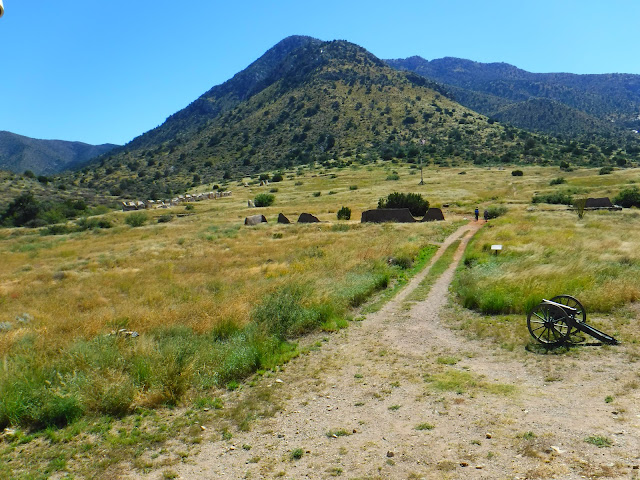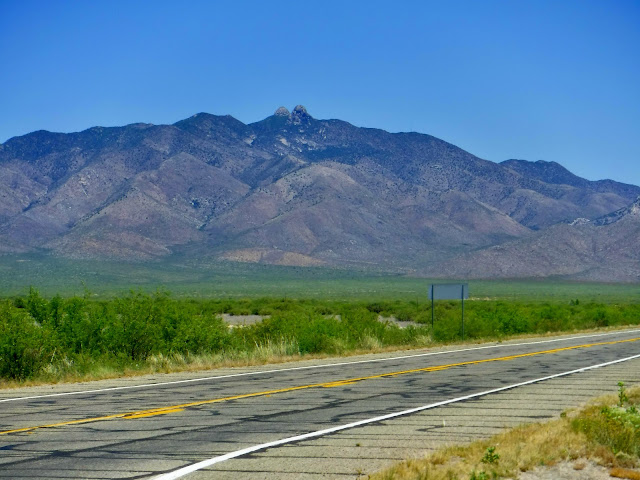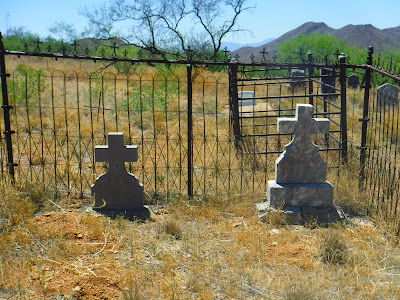Sit down with a cup of coffee, dear reader - this is a long one! Scroll down to the subsection below titled "The Sting" if you are solely interested in a timeline of what an actual bark scorpion sting feels like.
Oh, the ubiquitous Arizona scorpion! The plague of desert dwellers everywhere, the scorpion in rural desert Arizona is as easy to find as the rocks they like to hide beneath. Desert dwellers know: "Always shake your boots out!" just as the young mothers who pioneered this region knew to put a mason jar on each leg of the crib to keep scorpions from climbing in with the baby. As a child I was taught to never put my hands or feet where my eyes can't see (advice that, when heeded, always served me well.) As an adult, moving to more remote, rural places that had more scorpions than blacktop, I knew not to walk around barefoot or in sock feet around the house.
Dad, a rockhound, had a black light to check rocks for fluorescence; he showed me how scorpions light up with a blacklight in the darkness, where you often can't see them with just a flashlight. They were part of growing up in the desert, and they showed up in the strangest places. Not just in resin bola ties and key chains at gas stations or at Sky Harbor's kachina-filled gift shops, either - you'd find them in the bottom of dusty drawers, or crawling across the living room carpet. The oddest place I found one was in the bottom of the hoof of a horse I'd just finished riding and washing in Cave Creek. I picked up the hoof to clean it out and to my surprise, an intact, uninjured scorpion clung inside the v-shaped depression called the "frog" of the hoof. I don't know how I managed to avoid being stung.
I recall visiting Lake Pleasant as a teenager and being shocked at the infestation of scorpions on the banks. Perhaps "Scorpion Bay" is the most apt place name in Arizona. While living in New River, not far from Lake Pleasant, the most common scorpions I encountered were the "Giant Desert Hairy Scorpion," aka hadrurus arizonensis. Impressively huge, docile, the Giant Desert Hairy Scorpions have a fairly mild sting, said to be on par with a bee sting. They're easier to see because of their size, and I'd rarely turn over a horse water tank without finding one beneath it. Scorpions are fond of moist areas like that, which is why you're often likely to find them in the bathroom. It was in New River (where I first acquired cats) I learned to appreciate how good cats are at finding and killing scorpions in the house. They'd yowl proudly when they located one, and often I'd find dead scorpions on the floor where the cats had somehow exterminated them.
Here, in Cochise County in the far southeastern corner of the state, I find primarily bark scorpions. I'm so used to them I rarely bother to kill them unless they're indoors or in the immediate place where I'm working outside. I'm familiar with their reputation, of course, not just from friends who've been stung, but from running across a litany of tales from the newspaper archives. Even 125 years later, it's hard not to pity little Lawrence Wilson. At eight years old, while playing in the street outside his Phoenix home in late August, Lawrence was stung on the big toe by a scorpion. The Tombstone Epitaph reported that Lawrence was "bitten;" papers of the time generally referred to it as a "scorpion bite" although scorpions don't envenomate their victims by biting but by stinging with that nasty-looking stabby thing on the end of their tail. Little Lawrence killed the scorpion and immediately ran inside to tell his parents he was sick. Sick he was: his tongue promptly swelled, and he developed a high fever. His parents wasted no time in summoning medical assistance, and while waiting for help to arrive, they tried every home remedy at their disposal to help their little boy. Tragically, by the time the doctor arrived, Lawrence's eyes had "turned" and he began convulsing. Shortly after the doctor got there, Lawrence died. Although scorpion stings were common, deaths were uncommon enough the family wondered what really killed their little boy. They searched the area where he'd been playing and, sure enough, found the dead scorpion right where he'd told them he'd killed it.
Faring better was Frank Wolcott of Tombstone. The July 19, 1890 Epitaph noted he was stung the previous Tuesday but despite being in great pain for a while, he was already much better. Not so fortunate was Mr. Charles Rapp. As reprinted in the August 2, 1886 Epitaph from the original publication in the Florence Enterprise, the paper's account of the incident is amusing enough I include it here verbatim:
Monday evening, just before retiring for the night, Mr. Charles Rapp sat down in close proximity to a pugnacious scorpion, and the indignant little creature resented the familiarity by shooting its double-duplex, soul-paralyzing sting in a delicate portion of Charlie's anatomy. Charlie performed a series of athletic evolutions and lit with his mouth on the neck of a bottle. But the Arizona antidote for "snake bite" was not strong enough to entirely counteract the scorpion poison, and Charlie suffered the torments of the damned till next day. He was confined to his bed several days, but is all right now.
The "torments of the damned" is descriptive enough to be straight out of the Schmidt Sting Pain Index, a text in which a brave entomologist voluntarily allowed himself to be bitten and stung by an extensive cadre of nasty stabby creatures so he could compare, rank, and (quite eloquently) describe the sensation of each. Justin O. Schmidt, however, didn't expose his more tender bits to the bites. Schmidt, by the way, did his research while working at the venerable Carl Hayden bee research center in Arizona. What better place to research slithers, stings, and hideous biters than my native state?
In 1894, the Epitaph carried a mention of scorpion stings being so prevalent in Chihuahua, Mexico, that the Mexican government offered a bounty for every 100 scorpions killed. The program was greeted with enthusiastic scorpion hunters - as were the popular scorpion-hunting contests in New River during the mid-1900s, with awards given for the biggest as well as the most scorpions gathered.
As the story of Lawrence Wilson sadly illustrates, children are most susceptible to severe reactions to scorpion stings. On a Thursday evening in mid-May, 1930 (note that these incidents all have summer / hot weather in common), Parley McRae of the pioneering McRae family in St. David (between Benson and Tombstone) was stung by a scorpion in his home. Parley's reaction to the sting was so severe "for a short time he was not expected to live," according to the Tucson Citizen. Fortunately, he rallied, and by the following Monday his parents were hopeful of his survival. Parley graduated the next year from high school. Tragically, Parley was killed in an explosion at the Apache Powder Plant in St. David in December, 1944 at just 30 years of age.
But back to the "torments of the damned." Despite being born in Arizona and having lived here my entire life, I counted myself fortunate to avoid experiencing such scorpion-induced torments until yesterday afternoon. For those who are curious just how the sting of a bark scorpion feels, I took notes throughout my scorpion journey. I'll recount them for you here in painful detail.
First off, I know better. I know to wear gloves and to look where I'm putting fingers. I know that the stack of bricks I'm using to make walkways and sitting areas is full of bark scorpions. Problem is, I don't always dedicate an hour or two to focus on brickwork: I grab a couple of bricks every time I walk by the stack, because I have a thing about "not walking empty handed" when there's so much to do on the ranch. And so, while grilling yesterday and waiting for the beef to cook, I spent the time picking up bricks for the patio I'm putting beneath the grill. I got complacent and I didn't cautiously turn over the brick to make sure there weren't any little devils lying in wait for my bare fingers.
I made it from the brick pile to the grill and set one of the bricks in place, then brushed the gravel away with my hand when I felt the sting. Despite being a scorpion-sting virgin, I knew immediately, beyond any doubt, this was a scorpion sting. It was a pain quite unlike any other I've experienced, different from a bee sting, an ant bite, or a puncture from a cactus spine. First, I felt a sharp stabbing pain I'd equate with the incision of a scalpel or a razor blade, immediately followed by tingling and numbness. I looked first at my hand to make sure nothing was sticking out of it, only to find a visible slit - not a puncture, but a slice - in my right middle finger just past the upper joint. There was, of course, no stinger jutting out. And only then was I smart enough to turn the brick over and find the small, reddish-fawn bark scorpion on the ground.
Now, bark scorpions are unique in the scorpion world, and it's worthwhile for any desert-dweller to know how to recognize them. They are the most venomous scorpion on the continent, capable of the most painful sting, and they are the scorpion most likely to cause death (although it is very rare in healthy, non-allergic adults). They pack a hell of a punch. Note that the tail on the scorpion that stung me is held to the side, flat, rather than curled above its back. This is the hallmark of the bark scorpion. They're a small scorpion; this one was maybe two inches long from nose to the bend in his tail. Not that you're going to see a scorpion, identify it, and then say, "Self, this is a particularly nasty bark scorpion! Do not let it sting you!" or, conversely, "Self! This is a relatively user-friendly envenomating Giant Desert Hairy Scorpion! Sting away, friend!" Instead, take note of the culprit when you've been stung so you know to pay particular attention to the fact if it will be a more severe sting, or to seek prompt medical assistance for your child if they are stung.
The Sting
My scorpion buddy stung me a little before three p.m. Within minutes of the sting, I felt tingling in my left (non-stung) hand. I could feel the effects of the venom coursing through my body, much as you feel the effects of medical contrast solution or morphine as it moves through your system before a diagnostic exam. I finished grilling my beef, trotted to the barn for some charcoal for a compress (not that it was going to help, but I figured it couldn't hurt), and went inside to wash the site. By now it was quite painful. I took a couple of Diphenhydramine (yes, I know it's not proven to be effective, but again, what could it hurt?) I mixed the charcoal with vinegar and coated my finger with it, then googled scorpion first aid.
As the sites suggested, I called the poison control line 1-800-222-1222 and asked for guidance. The pleasant fellow who answered told me not to take Benadryl, as it wouldn't do anything ("Too late!" I said) and to expect pain for three to six hours and perhaps to expect to be sick for two or three days. He said I may expect to have trouble swallowing, as well as numbness and tingling. He said to watch out for signs of a severe reaction: twitching muscles, bouncing eyes, seizures, and to go to the emergency room if I had such symptoms. I told him I was 45 miles from a hospital and asked if I should "mosey" in that direction just in case; he said it probably wouldn't be necessary. Reassured, I settled in, had my steak, and elevated my hand while intermittently putting a cold pack on it. I sweated profusely for the first hour but hey, it's summer in Arizona.
By four p.m., I had aching in both shoulders and my neck and severe pain in the finger that exploded with even the slightest bit of touch or pressure. Weirdly, there was no redness or swelling. The pain felt like an ongoing, relentless, severe electrical shock, worse than that of an electric fence. My blood pressure shot up temporarily - something like 170+ over 98, followed by 151/ 93, but came down after I'd sat down and relaxed for a while. Someone from the poison control center kindly called me back - from Benson, rather than the nationwide center - to check up on me around this time. Good work, poison control!
The intensity continued to increase and by 4:25, it felt like an electrical throbbing. By five thirty, I was in extreme pain as well as having agitation and restlessness, particularly in my legs. I couldn't sit still. Somewhere around this time I did notice swallowing was difficult but not distressingly so; it was similar to trying to swallow a lump of almost-dry bread without something to wash it down.
By 5:40, I was suddenly sleepy and in extreme pain, but I couldn't sleep. Gah! Ten minutes later, the pain was almost intolerable. For the record, I didn't take any pain killers, so I can't tell you if they would have helped or not. I raw-dogged this ride! The pain peaked sometime around six p.m.
By 6:45, the pain was bad but had tapered off slightly. Half an hour later, the pain was bad but had improved significantly. My finger was, by then, numb from nailbed to tip. Numb, that is, unless I touched it or bumped it. Both my pinky and my ring finger on that hand were also tingling and slightly numb.
Before bedtime I packed my finger with arnica gel and lidocaine and bandaged it. Although pain was already vastly improved, I suspect the two topical remedies helped.
From there on out, the pain was tolerable and I was able to sleep by eleven. I woke up, as usual, at 3:30 a.m. and my finger was quite numb. My shoulders still ached, and my neck hurt. At 4:30 my husband person checked on me to see if I was "still alive." I was, and I was actually pretty comfortable.
By 6:30 this morning, other than the numbness, I had minor discomfort: aching in my shoulders and neck, and just felt "off," but not severely so. I was able to do the morning chores without difficulty. Now, late at night, I still have a disconcerting numbness, with the tip and the side of the finger that was stung nearly completely dead to sensation. The incision where I was stung is still visible but there's no redness, no swelling, nothing to indicate what had happened. Apparently this is because, unlike a rattlesnake, the scorpion venom is designed for self-defense, not because it plans on eating you. A rattlesnake venom will start to break down the flesh to make it easier to ingest, but a scorpion's venom doesn't tenderize you; it goes straight to your bloodstream to make you miserable.
Update: It's a day and a half after the sting, and my finger is still numb.
Here's my Yelp review of Scorpion Sting Adventure:
0/5 stars. Do not recommend! There are far better rides than this one! Do not take this trip: Not recreationally, not for profit, not on a dare, not on a bad bet. Just don't.
And so I count my blessings that I did not go the way of young Lawrence Wilson, nor did I get stung on a tender bit like Charlie Rapp. Not that Scorpion Sting Adventure was on my bucket list, but I finally earned my Scorpion Merit Badge at this late stage in life.
Be careful out there, and, as my dear old friend Jim used to tell me at the end of each phone call, "Be aware of the world around you!"
Get your scorpion merch here! These are affiliate links, meaning I may earn a small percentage of each sale at no extra cost to you. Thank you for the support. It helps feed the donkey and fund my mishaps.
Useful guide: Audubon Guide to Insects and Spiders
Cool shirt, and the best way to hear someone say, "Hey! There's a scorpion on you!" Retro Scorpion Graphic Tee
And finally, for my fellow Arizona oldsters who grew up seeing scorpion-in-resin keychains in every store, take a nostalgic trip back! The perfect "white elephant" gift for the workplace. Scorpion Key Chain
(c) 2025 Marcy J. Miller * All rights reserved * No part of this content may be used without the express permission of the author * Links to this page, however, may be freely shared, and thank you for doing so * Most of all, thanks for stopping by!





























































